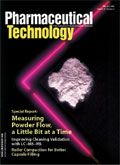Sweet Mix-ups and Sour Data
"It was the late 1970s," reports our GMP-Agent-in-Place, "and we used a primitive desktop computer with built-in teletype for our quality control work.
Today's lunch: data gone awry
"It was the late 1970s," reports our GMP-Agent-in-Place, "and we used a primitive desktop computer with built-in teletype for our quality control work. I'm not sure if it had any integrated circuits in it, just discrete transistors and resistors on multiple big-circuit boards. It stopped calculating correctly, and the three of us in the office stopped using it. The diagnosis alone would have cost more than the machine was worth at that point. But, we didn't 'tag' it out as nonfunctional.

Control
"Little did we know that a clerk from another division had been coming in on her lunch hours to use it, so as not to bother us," says our GMP Agent. "The clerk had been doing this for years, apparently, but we were new and never realized that it was going on.The clerk used it for several months after we determined it wasn't working correctly, but never realized the answers she was given were wrong.
"Boy, was she mad, as was her supervisor, when they realized all that work had to be redone. And we got royally reamed," sighs the GMP Agent.
The seven-year switch
"So along comes the laboratory minicomputer," our proud GMP-Agent-in-Place states. "It was going to save us time, especially in those computation-intensive statistical analyses.
"The management information systems (MIS) staff did a bang-up job programming the linear regression analysis. The statisticians not only provided test data, but also reviewed the code itself to be sure the correct formulas were used. There were soon four signatures gracing the acceptance report, and each year the test data were rerun to ensure the program was working as expected. This was long before computer validation had become a way of life in the pharmaceutical industry."
Now flash forward seven years. Some unusual test results made it clear that, at least in one case, the program did not work correctly. Our GMP-Agent-in-Place was assigned to look into this and found that the MIS programmer had switched the x and y axes. This change wasn't obvious in the test data and went undetected by the statisticians' reviews. Seven years of calculations were wrong, and seven years of products released using this program were potentially adulterated.
"In the end, it turned out that most tests using this program had slopes close to 1," explains our Agent, "and the error in the assays in these cases was too small to worry about."
A beet by any other cane is not as sweet
A particular injectable product contained table sugar—highly purified, yes, but ordinary sugar nonetheless. Our GMP-Agent-in-Place recounts that company management wanted to shut an older factory where this sugar-containing product was made and move it to another site. The process would apparently be easy because the product was easy to make. Another site was chosen, and development batches were scheduled.
"It wasn't that simple," anguishes our GMP-Agent-in-Place. "The new site was already getting sugar from a different supplier—cane sugar rather than beet sugar—and didn't want to add a new supplier. After all, 'sugar is sugar' and both met compendial requirements."
The product was manufactured using the alternate supplier, and met all specifications. Once the product was in the field, however, adverse reactions started coming in, but only for the product containing cane sugar. "Although in the end we didn't need to recall any batches," explains our GMP-Agent, "we did extensive work and found that the problem was trace amounts of polysaccharides in the cane sugar. Now, the raw material specification includes a test for polysaccharides."
Pharmaceutical Technology's monthly "Agent-in-Place" column distills true-life cautionary tales from the secret files of Control, a senior compliance officer. If you have a story of clueless operators, oblivious management, inopportune lapses of judgment, or Murphy's Law in action, please send it to Control at AgentinPlace@advanstar.com We won't use any names, but if we do use your tale of disaster, courage, or just plain weirdness, Control will send you a coveted Pharmaceutical Technology t-shirt.
